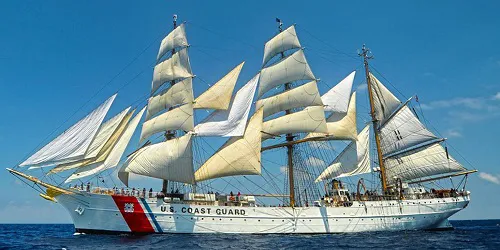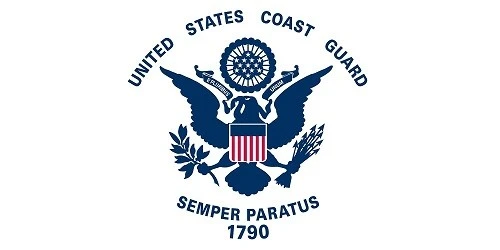-
Register Now for a Free Account!Unlock additional site access with your free account today, takes less than a minute, and guaranteed no spam - ever. Register Now!
CGC Eagle #8 Oldest Active Military Ship - Cruising Earth

CGC Eagle - United States Coast Guard
#8 Oldest Active Military Ship
CGC Eagle is currently ranked #8 in the list of the Oldest Active Military Ships.
CGC Eagle Historical Brief
Introduction
The United States Coast Guard Cutter (USCGC) Eagle, often referred to as "America's Tall Ship," is a majestic barque that serves as a training vessel for future officers of the United States Coast Guard. With its striking appearance and storied history, the Eagle has become a symbol of maritime heritage and the enduring values of the Coast Guard. This historical brief provides an overview of the Eagle's construction, acquisition by the United States, training role, and cultural significance.
Construction and Early Years (1936-1946)
The ship that would become the USCGC Eagle was originally built in 1936 by the Blohm & Voss shipyard in Hamburg, Germany. It was one of three sail training ships commissioned by the German Navy, known as the Horst Wessel, Gorch Fock, and Albert Leo Schlageter. The vessel was named Horst Wessel, after a Nazi party member who was regarded as a martyr by the regime.
Constructed with a steel hull and wooden decking, the Horst Wessel was designed as a barque with three masts, standing at 295 feet (90 meters) in length overall, with a beam of 39 feet (12 meters) and a draft of 17 feet (5 meters). The ship's rigging includes 21,350 square feet of sail area, allowing it to harness the power of the wind effectively. It was intended to train cadets in seamanship, navigation, and leadership, providing practical experience in sailing.
During World War II, the Horst Wessel was used by the German Navy for training purposes and, towards the end of the war, it was repurposed for various other roles, including serving as a cargo vessel and a troop transport. The ship survived the war with minimal damage and was found by the Allies in Bremerhaven, Germany, at the war's conclusion.
Acquisition by the United States (1946)
As part of the war reparations following World War II, the United States acquired the Horst Wessel. On May 15, 1946, the ship was commissioned into the United States Coast Guard and was renamed the Eagle. It was decided that the Eagle would serve as a training vessel for the United States Coast Guard Academy, located in New London, Connecticut.
Before the Eagle could make its journey to the United States, it underwent necessary repairs and modifications to meet American standards and to ensure it was seaworthy. On June 20, 1946, the ship set sail from Bremerhaven to its new home in New London, Connecticut, with a crew composed of German sailors and American Coast Guard personnel.
Training Role and Operational History (1946-Present)
Upon its arrival in the United States, the Eagle began its new role as a training vessel for the Coast Guard Academy. Since then, it has been an integral part of the Academy's curriculum, providing cadets with hands-on experience in seamanship, leadership, and teamwork. The training cruises aboard the Eagle are designed to challenge cadets physically and mentally, instilling in them the skills and values necessary for their future careers as Coast Guard officers.
The Eagle's training missions have taken it to numerous ports around the world, from the Caribbean and Latin America to Europe and Asia. These voyages are often part of the summer training program for cadets, lasting several weeks and covering thousands of nautical miles. During these cruises, cadets learn to handle sails, navigate by the stars, and perform a variety of shipboard tasks, all while living and working in close quarters with their shipmates.
In addition to its training role, the Eagle has participated in numerous international events, tall ship races, and maritime festivals. These events allow the ship to serve as a floating ambassador for the United States, promoting goodwill and fostering international relations. The Eagle's participation in events such as Operation Sail and the Tall Ships Challenge has helped to showcase the United States' maritime heritage and the Coast Guard's commitment to excellence.
Modernization and Upgrades
Over the years, the Eagle has undergone several refits and upgrades to ensure its continued operational effectiveness and safety. These upgrades have included improvements to the ship's rigging, hull, and onboard systems. Modern navigation and communication equipment have been installed to enhance the ship's capabilities while maintaining its historical character.
One significant refit occurred in the 1980s, during which the ship's hull was reinforced, and its electrical and mechanical systems were updated. More recent upgrades have focused on improving the ship's safety and habitability, ensuring that it remains a comfortable and effective training platform for cadets.
Cultural and Diplomatic Significance
The USCGC Eagle is not only a functional training vessel but also a powerful symbol of American maritime heritage and the Coast Guard's values. The ship's name, Eagle, reflects its role as a representation of the nation's ideals and traditions. The Eagle's elegant design and historical significance have made it an enduring symbol of the Coast Guard and its mission.
The ship's involvement in state visits and international events also serves to strengthen the United States' diplomatic ties and promote cultural exchange. The Eagle's voyages have taken it to numerous countries around the world, where it has been received with admiration and respect. These visits help to enhance the United States' global standing and foster mutual understanding between nations.
One of the Eagle's most notable roles is its participation in the annual Coast Guard Day celebrations, which commemorate the founding of the United States Coast Guard on August 4, 1790. The ship's presence at these events highlights its significance as a living link to the Coast Guard's storied past and its ongoing commitment to service.
Preservation and Future Prospects
As the Eagle continues to serve the Coast Guard, efforts to preserve its historical integrity and operational capabilities are ongoing. Regular maintenance and periodic refits are essential to ensuring the ship's seaworthiness and safety. These efforts are also crucial in preserving the ship's legacy for future generations of cadets and the public.
The future prospects for the Eagle are promising. The ship will continue to play a vital role in the training of Coast Guard officers, providing them with the skills and experience necessary for their careers. Its participation in international events and cultural exchanges will also endure, promoting the United States' maritime heritage and fostering global understanding.
In recent years, there has been a renewed interest in traditional sailing vessels and their role in naval training. The Eagle's continued service is a testament to the enduring value of hands-on seamanship training and the importance of preserving maritime traditions. The ship's combination of historical charm and modern functionality makes it a unique and invaluable asset to the United States Coast Guard.
Conclusion
The United States Coast Guard Cutter Eagle stands as a testament to the United States' rich maritime history and its commitment to training and excellence. Since its commissioning in 1946, the ship has trained countless Coast Guard cadets, participated in significant historical events, and promoted cultural exchange and diplomacy around the world. As it continues to sail the world's oceans, the Eagle remains a symbol of the United States' enduring maritime legacy and its dedication to the values of seamanship, tradition, and international friendship.
The Eagle's historical significance, elegant design, and ongoing role in naval training and cultural diplomacy make it an important and cherished part of the United States Coast Guard. As it approaches its centenary, the ship's legacy will continue to inspire future generations of sailors and maritime enthusiasts, preserving the rich nautical traditions of the United States for years to come.


